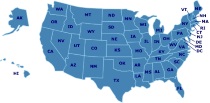The Legal Journey
Learn about the legal, social, political, and philosophical journey towards legal homeschooling in the United States.
The Legal Journey
HSLDA: Our History
Although HSLDA has changed over the past 30 years—in terms of the size of our membership and staff and our physical location—our original vision and purpose remain unchanged. HSLDA exists expressly for the purpose of advocating family and freedom.
The Battle of H.R. 6
House Resolution 6 of 1994 was a reappropriations bill for the Elementary and Secondary Education Act (ESEA). Ordinarily such bills deal with public education and would have little, if any, impact on home educators. But that year, a few small wording changes affected thousands upon thousands of home schooling families, and resulted in over a million phone calls to Congress.
Marking the Milestones: Historical Times
This timeline highlights the important milestones in the fight for homeschool freedom in the United States.
On the Edge of the 21st Century
The right to home school is based on two fundamental principles of liberty: religious freedom and parental rights. Whenever one of these two freedoms is threatened, our right to home school is in jeopardy. Here are the battles we think home educators will be facing as we enter the next century:
The Politics of Survival: Home Schoolers and the Law
Twenty years ago, home education was treated as a crime in almost every state. Today, it is legal all across America, despite strong and continued opposition from many within the educational establishment. How did this happen? This paper traces the legal and sociological history of the modern home school movement, and then suggests factors that led to this movement's remarkable success.
The Good, The Bad, The Inspiring
A look back at the history of the Home School Lega Defense Association with Michael P. Farris, J. Michael Smith, Christopher J. Klicka, and David E. Gordon. Hear about the early years of HSLDA, the way home schooling has changed, and some of their most memorable cases.
A Fifteen Year Perspective
When Michael Farris and Michael Smith founded Home School Legal Defense Association in March of 1983, home schooling was just a tiny blip on the education radar screen. The concept of parents teaching their children at home was relatively obscure, and the families who chose to follow this non-traditional education route were fairly certain to face opposition from the educational bureaucracy and following legal entanglements, as well as from their own friends and family.
Homeschooling Is Legal: A Brief History of Home School Legal Defense Association
This article, written in 1998 on the fifteenth anniversary of Home School Legal Defense Association (HSLDA), chronicles HSLDA’s growth.
The Lessons of H.R. 6
For eight days in February, 1994, the home schoolers of this nation gave Congress a lesson on the power of grassroots politics it is not likely to forget. It began when an amendment was introduced to H.R. 6, an enormous education reappropriations bill, which would have required all teachers in America to be certified in each and every course they teach. (See article on “The Battle of H.R. 6.”) This provision would have encumbered public schools—especially small public high schools. It would have seriously interfered with America’s private schools. But for home schools, the provision was the political equivalent of a nuclear attack. America’s home schoolers astonished Congress with a political counterstrike that was quick, effective, massive, and decisive. There are three central reasons why the home schooling community was able to respond in this manner.
Featured Resources
As an Amazon Associate, we earn from qualifying purchases. We get commissions for purchases made through links on this site.
A Charlotte Mason Education: A Home Schooling How-To Manual
The immensely popular ideas of Charlotte Mason have inspired educators for many decades. Her unique methodology as written about in her six-volume series established the necessary protocols for an education above and beyond that which can be found in traditional classroom settings. In A Charlotte Mason Education, Catherine Levison has collected the key points of Charlotte Mason's methods and presents them in a simple, straightforward way that will allow families to quickly maximize the opportuni...
National Geographic Guide to the National Parks of the United States, Fourth Edition
Now in its fourth edition, the National Geographic Field Guide to the Birds of North America is the ultimate birder’s field guide. Sturdy, portable, and easy-to-use, it features the most complete information available on every bird species known to North America. This revised edition features 250 completely updated range maps, new plumage and species classification information, specially commissioned full-color illustrations, and a superb new index that allows birders in the field to quickl...
Idea Book For Cuisenaire Rods At The Intermediate Level
Grades 2-5. Idea Book designed for use with Cuisenaire Rods.
Montessori International
Montessori International is the magazine for all parents and teachers. Montessori International magazine is a high quality colour education magazine with a Montessori focus and a truly child-centred approach. The magazine is for Montessori parents, nursery owners, teachers, and students with an interest in Montessori education.
The Outdoor Life of Children: The Importance of Nature Study and Outside Activities (Charlotte Mason Topics - Volume 2
The methods of Charlotte Mason are popular among homeschoolers. She includes nature study as a crucial element. This work explores the idea of the outdoors as a classroom for children, and gives tips on ways of teaching the sciences, history, literature, music, and art through the use of outdoor space.




